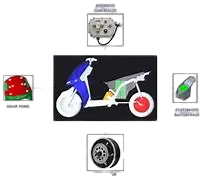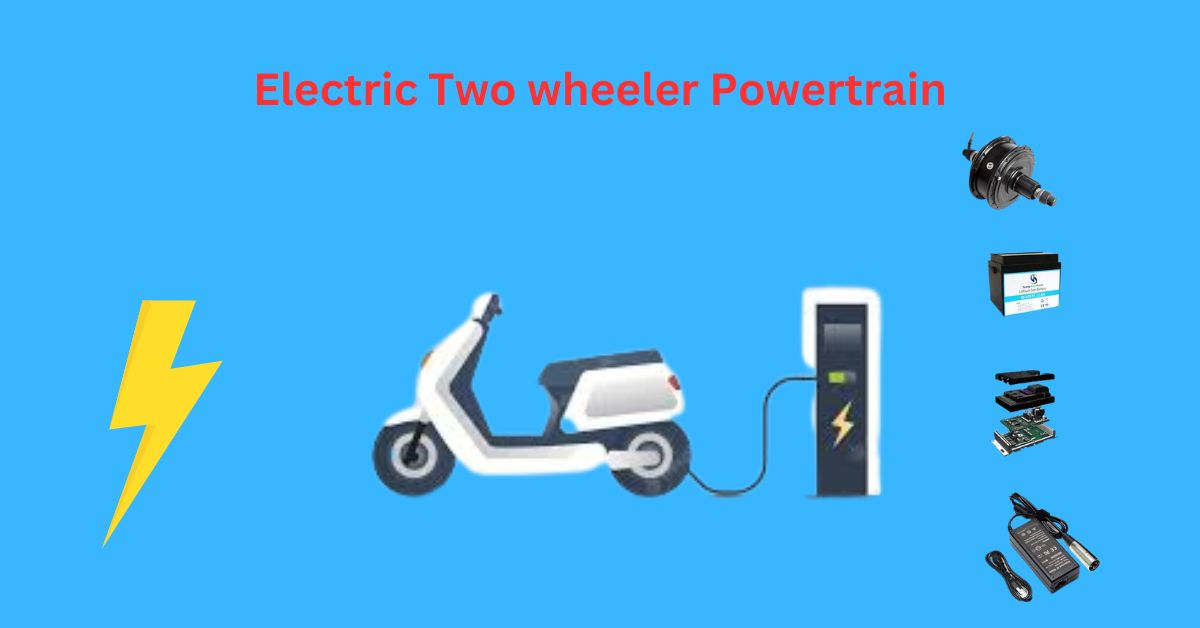Powertrain
Let us understand first what is the powertrain—the most commonly used word in all kinds of automotive vehicles.
In very simple words, the powertrain is a joint effort of the entire mechanism of the vehicle which propels the vehicle to move forward.

Nowadays, electric vehicles are becoming more popular than ever before, and electric two-wheelers are at the forefront.
These vehicles are comparatively small, agile, and eco-friendly, making them perfect for urban mobility.
Interestingly, among electric two-wheelers, one of the key factors that make electric two-wheelers so appealing is their powertrains. Electric powertrains are simple, efficient, and reliable.
Moreover, they also offer multiple advantages over traditional gasoline engines, such as lower emissions, lower noise, and lesser maintenance costs.
In this blog post, we will take a closer look at electric two-wheeler powertrains. We will also discuss the different components of a powertrain, how they work, and the advantages they offer.
So, if you are interested in learning more about electric two-wheeler powertrains, then this post is for you!
What is a Powertrain
A powertrain is a system that converts fuel or other energy sources into mechanical energy to power a vehicle.

In the case of electric two-wheelers, the powertrain consists of three main components: the electric motor, the battery pack, and the electronic control unit (ECU).
The electric motor is responsible for converting electrical energy into mechanical energy, which is further used to drive the vehicle’s wheels.
Notably, the battery pack serves as the energy reservoir that powers the motor. The ECU(controller) acts as the brain of the powertrain, regulating the flow of electricity and managing various aspects of the vehicle’s performance.
Types of Electric Two-Wheeler Powertrains
There are two main types of electric two-wheeler powertrains: hub motor powertrains and mid-drive powertrains.
Hub motor powertrains
Hub motor is integrated directly into the wheel hub.
This configuration offers a simple and compact design, resulting in reduced maintenance and increased efficiency.
Thus, hub motor powertrains are popular in electric scooters and smaller motorcycles.
Mid-drive powertrains
In a mid-drive powertrain, the electric motor is positioned at the centre of the frame, typically near the bottom bracket.
Resulting, this design provides better weight distribution and improved handling, making it ideal for electric mountain bikes and high-performance motorcycles.
Working Principle of Electric Two-Wheeler Powertrain
The operation of an electric two-wheeler powertrain can be summarized in a few key steps:
- The battery pack supplies electrical energy to the electric motor through the ECU(controller).
- The ECU regulates the power output based on the rider’s input and the vehicle’s requirements.
- When the rider engages the throttle, the ECU sends a signal to the motor, causing it to rotate.
- As the motor spins, it generates torque, which is transferred to the wheels through a transmission system or directly in hub motor designs.
- The charger is used to recharge the battery. It converts electrical energy from the mains into electrical energy that can be stored in the battery.
Advantages of Electric Two-Wheeler Powertrains
Electric two-wheeler powertrains offer a wide range of advantages that make them an attractive option for both commuters and enthusiasts.
Eco-friendly and zero emissions
Electric two-wheelers produce zero tailpipe emissions, significantly reducing their carbon footprint and contributing to cleaner air and a healthier environment .
Quieter Operations
Electric powertrains work silently, providing a noise-free riding experience. This characteristic is particularly beneficial in urban environments, reducing noise pollution and creating a more pleasant atmosphere.
Low maintenance
Electric two-wheelers require lesser maintenance, as there is no need to change oil or tune-ups required.
This can save riders a significant amount of money in the long run.
Quick acceleration
Electric motors deliver instant torque, providing immediate acceleration and responsiveness.
This makes them exceptionally easy to ride, especially in urban environments where quick acceleration is often needed.
Performance and Efficiency
In addition to their environmental and economic advantages, electric two-wheeler powertrains also offer more impressive performance characteristics than traditional internal combustion engines.
Instant torque
Electric motors deliver instant torque, providing immediate acceleration. This makes them an exceptionally smooth ride.
Energy efficiency
Electric powertrains are highly efficient, converting a larger percentage of energy from the battery to power the wheels. This leads to longer ranges and reduced energy consumption.
Future Prospects
Considering the advantage of electric two-wheeler powertrains future is very promising.
Continuously ongoing research and development, we can expect significant improvements in battery technology, resulting in enhanced performance and longer driving ranges.
Additionally, the incorporation of regenerative braking systems and advancements in lightweight materials will further optimize energy efficiency and overall vehicle dynamics.
Impact on Urban Mobility
Electric two-wheelers have the potential to revolutionize urban mobility.
Their compact size and easy ride make them ideal for navigating congested city streets, offering a practical and eco-friendly alternative for commuters.
In our urban areas the priority is sustainable transportation, electric two-wheelers is the right choice for modern urban mobility.
Conclusion
Electric two-wheeler powertrains are a promising technology that has the potential to revolutionise transportation.
Additionally, these powertrains offer several advantages over traditional gasoline-powered powertrains, including lower emissions, lower operating costs, and greater efficiency.
As the technology continues to develop, electric two-wheeler powertrains are going to become more popular in the upcoming times.
If you are looking for a sustainable and efficient way to get around, an electric two-wheeler is a great option.
FAQ
What is an electric two-wheeler powertrain?
A powertrain in an electric two-wheeler refers to the system that connects the electric energy source (battery pack) with the mechanical energy needed to drive the wheels.
It includes the electric motor, battery pack, and electronic control unit (ECU) that manages the flow of electricity and controls the vehicle’s performance.
How does the powertrain in an electric two-wheeler work?
The powertrain operates by receiving electrical energy from the battery pack, which is then sent to the electric motor through the ECU.
When the rider engages the throttle, the ECU signals the motor to rotate, generating torque that drives the wheels and propels the vehicle forward.
How far can electric two-wheelers travel on a single charge?
The driving range of electric two-wheelers varies depending on factors like battery capacity, vehicle weight, terrain, and riding style.
Advances in battery technology have extended ranges in modern electric two-wheelers, with some models achieving over 100 miles on a single charge.
What are the challenges faced by electric two-wheeler powertrains?
Electric two-wheelers face challenges such as:
- Range Limitations: Limited energy storage in batteries can restrict driving ranges, especially for high-performance models.
- Charging Infrastructure: The availability of charging stations may be limited, requiring further expansion to promote widespread adoption.
- Initial Cost: The upfront cost of electric two-wheelers can be higher than traditional counterparts, though operating costs and maintenance expenses are generally lower.
How long does it take to charge an electric two-wheeler battery fully?
The charging time for electric two-wheelers varies depending on the battery’s capacity and the charging method used.
Typically, using standard home chargers, it may take a few hours to fully charge the battery, while fast chargers can significantly reduce the charging time.
Can electric two-wheelers be used for long-distance commuting?
With advancements in battery technology, electric two-wheelers are becoming increasingly capable of long-distance commuting.
However, for extended trips, careful planning and access to charging infrastructure along the route may be necessary.
Are electric two-wheelers suitable for hilly terrains?
Electric two-wheelers are well-suited for hilly terrains due to their instant torque delivery, which provides excellent hill-climbing capabilities.
Mid-drive powertrains, in particular, offer better weight distribution and improved handling on challenging terrain.
What does the future hold for electric two-wheeler powertrains?
The future of electric two-wheeler powertrains is promising. Advancements in battery technology will likely lead to increased range and improved performance.
As more cities embrace sustainable transportation, electric two-wheelers are expected to become a common sight, revolutionizing urban mobility and reducing environmental impact.

